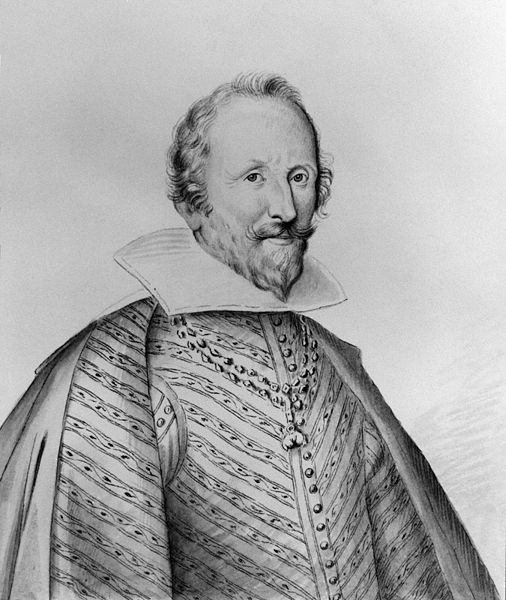.jpg/451px-Wenceslas_Hollar_-_Prince_Rupert_(State_2).jpg) |
| Prince Rupert |
A Volte-Face
The Royal
Navy had fought on the Parliamentarian side in the first Civil War under the Earl of Warwick. Warwick was replaced by William Batten who deplored the capture of the king and in 1648 it was
planned to replace Batten with an extremist, Colonel Thomas Rainsborough.
Ten warships,
stationed at the Downs, mutinied in May 1648 after the second Civil War broke out. They sailed to Hellevoetsluys where they were met by Prince Rupert and the Prince of Wales.
Batten arrived later in the Constant Warwick, an armed merchantman that he part
owned.
Rupert favoured
the small fleet sailing to the Isle of Wight and rescuing Charles who was held prisoner in Carisbrooke Castle. By the time the fleet sailed in July under Prince
Charles’ command and Baron Willoughby of Parham as Vice-Admiral, there were 18 ships in the fleet. Merchant ships departing
the Thames estuary were taken as prizes and two
attempts to stop the recapture of Deal and Walmer castles were unsuccessful. Rupert noted;
‘Upon this repulse disorders
and discontents increasing in the fleet, and all disadvantages being
artificially improved, it was thought.....best to return to Holland.’[i]
The Earl of
Warwick was reappointed to head up the navy and Prince Charles challenged him
to a battle. Warwick refused to fight and shortages of supplies and ammunition
forced the fleet to return to the Netherlands. Batten sailed off with his ship,
having received a pardon from Warwick.
A Naval Career
 |
| Hellevoetsluys |
Warwick’s
fleet blockaded the Royalists in Hellevoetsluys for several weeks, but the two
fleets could not come to blows as the Dutch navy under van Tromp was interposed
between them. They could not stop Warwick’s men infiltrating the town and
trying to bribe the Royalist sailors.
Ashore
Rupert clashed with one of Prince Charles’ more fiery tempered advisers, Lord Culpepper. When Culpepper objected to the
inclusion in an expedition of one of Rupert’s friends Sir Robert Walsh, both
men became embroiled in an argument and Culpepper challenged Rupert to a duel.
 |
| Lord Culpepper |
Prince
Charles asked Culpepper to apologise, but he refused and it was only several
days later, after discovering that he had no support from his fellow courtiers,
that he finally did so. Rupert accepted the apology despite the active efforts
of one Sir Edward Herbert, the manipulative Attorney General, who then worked Walsh into such a
rage that Walsh punched Culpepper in the face. He drew his sword, only
desisting when he realised his opponent was unarmed[ii].
As news
trickled in of Royalist losses Rupert was unable to stop defections from his
men and the Royalist fleet gained a reputation for aggression and wildness,
drawing protests from the Dutch authorities. Eventually the bulk of the
Royalist ships joined the Parliamentarian fleet leaving Rupert with only eight
ships.
Warwick’s
ships left at the end of the year and Rupert sent raiding parties out. The
Parliamentarian ambassador extraordinary to the Court at den Haag, Walter Strickland wrote to the Speaker of the House of Commons William Lenthall;
‘I am sorry what I must tell
to you that the revolted ships come in daily with great prizes......it is no
great joy to me to see our merchants beggared.’[iii]
Times of Sorrow
 |
| Execution of King Charles |
Rupert was
made admiral of the fleet on 5th January 1649, a command he accepted
with the proviso that James, Duke of York[iv] be the Lord High Admiral. Rupert had Maurice as his
Vice-Admiral and Sir John Mennes[v] was appointed Rear-Admiral. Rupert had the small fleet refitted
early in 1649[vi];
the only crumb of comfort for Royalists at a time when King Charles, having
been tried and found guilty, was executed on 30th
January.
Culpepper
was one of many attempting to undermine Rupert; the Stuart court in exile
unable to join together in attempts to prosecute the war. But one of Rupert’s
detractor’s Edward Hyde was impressed by Rupert’s efforts;
‘The preservation [of the
fleet] whereof must be entirely ascribed to Prince Rupert, who seriously hath
expressed greater temper and discretion in it than you can imagine.’[vii]
Rupert took
his small undermanned fleet to Kinsale where the news of his uncle’s death awaited him. Charles had partially
filled the space left by the loss of Rupert’s father and Charles’ nephew
undoubtedly sincerely mourned the loss of the uncle he loved.
 |
| Princess Louise |
Rupert’s
siblings were also hit by the death of their uncle, Elizabeth becoming
seriously ill. Rupert also had to calm down his volatile mother; her upset not
so much at her brother’s death but more caused by the entry of her daughter Louise[viii] into the Cistercian convent, Maubisson Abbey, as a novice in March. Prince Charles
now declared himself King Charles II, but he was strapped for cash and he too
looked to his cousin to provide.
From Kinsale
Rupert managed to supply the Royalists holding out in the Scilly Isles[ix]. The fleet lost the Charles in a fog, which was then taken by
the enemy. But the depredations caused by Rupert’s ships forced Parliament to
institute a convoy system to protect the fleets carrying troops to aid
Cromwell’s ruthless campaign in Ireland.
In May 1649
a Parliamentarian fleet, under the command of Robert Blake[x], appeared outside Kinsale harbour
and blockaded the Royalists. Rupert was refused permission to attack and the
fleet was kept penned in. Rupert lost William Legge when his frigate was seized
outside the harbour.
Charles II
and his court repaired to St Helier in mid-September; infighting and Charles’ inherent laziness kept them
there. It was there that the news of Cromwell’s victories at Wexford and Drogheda[xi] reached them.
Mediterranean Escapade
 |
| King John IV of Portugal |
Winds finally
dispersed Blake’s fleet and on 17th October Rupert and his ships set
sail for Portugal, following an invitation from King John IV. On the voyage the ships lost contact with one another, as
Rupert explained to his cousin;
‘It happened in the night by
mistake of a fight alle our Fleete except Sir Jo: Menes lost me......Wee
therefore plyed as much to windward as wee could......wee made early in the
morning 7 shipps to windward wee gave chase to them & they to us which proved
to be our Fleete.’[xii]
The little
fleet sailed up the Tagus to Lisbon in mid-November having taken three or four prizes en route. Hardly had
they arrived before the English government lodged protests followed shortly by
the Dutch and the Spanish[xiii]. Rupert sold off some
of his prizes, including the Roebuck[xiv] which caused a storm in
Lisbon.
Blake’s
fleet followed the Royalist ships in March 1650; Blake carried an ambassador
who demanded that Rupert, Maurice and the ships be handed over or forced into
open waters. Despite pressure from his advisers John refused and was informed
that Blake and his fleet would feel free to attack Portuguese shipping. There
was a split in the court and John’s adviser, the Count de Miro, was all for
throwing Rupert and his men to the wolves.
Unwelcome Visitors
Rupert
concentrated his energies on the clergy who sympathised with his plight; they
preached the shame of the Christian king treating with the rebels. Rupert also made
sure to show himself to the people of Lisbon; he had always been easy dealing
with people from all backgrounds.
Rupert rode
to the hounds every day and the Parliamentarians, reduced to skulduggery,
attempted to kidnap Rupert and his brother on one such expedition. The brothers
managed to ride off, evading capture.
Rupert
received a letter from his cousin Charles, begging for financial aid. The naïve
Charles told Rupert to raise the money by privateering. An attempt in July to
break through Blake’s blockade failed when the mast of Rupert’s ship was struck
in a fight. A second attempt in September was foiled when one of de Miro’s men
informed Blake of Rupert’s plans.
I
n October
Blake ordered a refit in Cadiz; having worn out their welcome. The Royalist fleet decided to take
advantage of the absence of the Parliamentarian blockade.
 |
| Cadiz |
‘The King.....victualled our
fleet , and fitted us with such other stores as were necessary for us, giving the
Princes many thanks for their endeavours to preserve the fleet, and assured
them of his friendship.’[xv]
They were
sent on their way; Rupert’s ships were to rendezvous in Formentera. But eager for booty the majority of his captains delayed
and were caught by the return of Blake’s ships. The Royalists dashed to Cartagena, hoping for sanctuary. But Blake’s men fired on them. In
desperation the captains ran their ships ashore after the crew of the Henry
went over to the enemy. Only Rupert and Maurice’s ships remained of the little
fleet.
Bibliography
Prince
Rupert of the Rhine – Maurice Ashley, Purnell Book Services Ltd 1976
The English
Civil War – Robert Ashton, Weidenfeld & Nicholson 1989
Charles the
First – John Bowles, Weidenfeld & Nicholson 1975
Cromwell –
Antonia Fraser, Phoenix Paperback, 2001
Charles I –
Christopher Hibbert, Penguin Books 2001
The Civil
Wars of England – John Kenyon, George Weidenfeld & Nicholson 1989
Prince
Rupert of the Rhine – Patrick Morrah, Constable & Company 1976
Man of War –
Richard Ollard, Phoenix Press 2001
The English
Civil War – Diane Purkiss, Harper Perennial 2007
Prince
Rupert – Charles Spencer, Phoenix Paperback 2008
www.wikipedia.en
[i]
Prince Rupert - Spencer
[ii]
Walsh was banned from Den Haag
[iii]
Rupert of the Rhine - Ashley
[v]
A very experienced naval officer
[vii]
Prince Rupert - Spencer
[viii]
Like her brother Louise was a talented artist and she converted to Catholicism
in December 1657, having fled to France
[x]
A friend of Cromwell’s
[xi]
Over 3,500 people, defenders and civilians were killed
[xii]
Prince Rupert of the Rhine - Morrah
[xiii]
Objecting to the piracy undertaken by Rupert’s fleet
[xiv]
This English ship carried Portuguese merchandise, so upsetting both the
Parliamentarians and the Portuguese. Another time two of Rupert’s ships gave
chase to a French ship which was captured by Blake’s fleet
[xv]
Prince Rupert - Spencer


.jpg/467px-Wenceslas_Hollar_-_Charles_I_(State_3).jpg)

.jpg/640px-Wenceslas_Hollar_-_Oxford_(State_1).jpg)
.jpg/527px-Jacobite_broadside_-_Portrait_of_Prince_Maurice_(1620-_1652).jpg)
